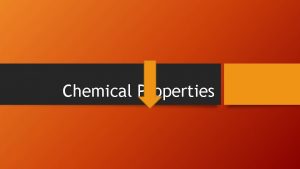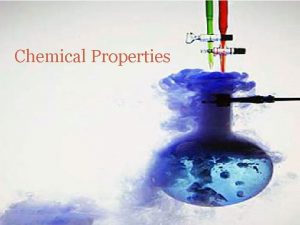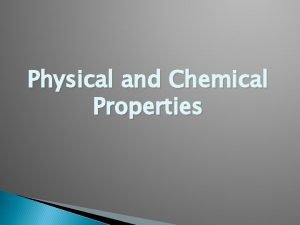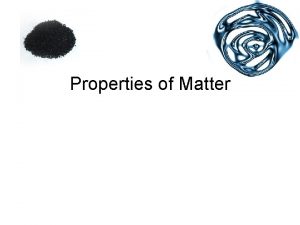Chemical Properties Chapter 2 Section 3 Chemical Properties










- Slides: 10

Chemical Properties Chapter 2 Section 3

Chemical Properties • A property of matter that describes a substance’s ability to participate in chemical reactions is a chemical property. • When wood is burned, smoke and ash are created. These have very different properties than the wood. • Two types of chemical properties are flammability and reactivity.

Flammability • The ability of a substance to burn is flammability. • Wood is flammable. It can burn. • Smoke and ash, created from a burning piece of wood, are unable to burn. They are nonflammable. • Rubbing alcohol and oxygen are also flammable. They will burn.


Reactivity • The ability of two or more substances to combine and form new substances is reactivity. • An iron nail can react with oxygen in the air to form rust, or iron oxide. • Chrome, which is nonreactive with oxygen, will not rust.

Comparing Physical & Chemical Properties • Physical properties can be identified without changing the identity of the substance. • You can observe the physical properties of matter without changing the matter. • Examples of physical properties are density, shape, and state. • Chemical properties are not as easy to observe.

Comparing Properties • You can only see that wood is flammable when it is actually burning. • You can only see that an iron nail is reactive with oxygen after it has rusted.

Characteristic Properties • Properties that are most useful in identifying a substance are characteristic properties. • These properties are always the same no matter what size the sample is. • Some characteristic properties are physical, like density and solubility. • Others are chemical properties, like flammability and reactivity.

Chemical Changes • A chemical change happens when one or more substances change into new substances that have new and different properties. • Some clues that chemical changes are taking place are changes in color or odor, heat being produced, fizzing, foaming, sound, and/or light.

Physical vs. Chemical Changes • Physical changes do not change the composition of the substance. • Grinding baking soda into a fine powder is a physical change. The substance is still baking soda. • Mixing baking soda and vinegar is a chemical change. A new substance is formed.
 Chemical property of matter
Chemical property of matter Section 2 classifying chemical reactions worksheet answers
Section 2 classifying chemical reactions worksheet answers Chemical reactions section 2 classifying chemical reactions
Chemical reactions section 2 classifying chemical reactions Chemical reactions section 1 chemical changes
Chemical reactions section 1 chemical changes Empirical formula pogil
Empirical formula pogil Love chemical formula
Love chemical formula Chapter 18 chemical reactions balancing chemical equations
Chapter 18 chemical reactions balancing chemical equations Chapter 18 review chemical equilibrium
Chapter 18 review chemical equilibrium Chapter 18 review chemical equilibrium section 3 answer key
Chapter 18 review chemical equilibrium section 3 answer key Chapter 8 review chemical equations and reactions
Chapter 8 review chemical equations and reactions Chapter 8 section 1 chemical equations and reactions
Chapter 8 section 1 chemical equations and reactions



















